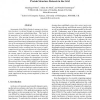Free Online Productivity Tools
i2Speak
i2Symbol
i2OCR
iTex2Img
iWeb2Print
iWeb2Shot
i2Type
iPdf2Split
iPdf2Merge
i2Bopomofo
i2Arabic
i2Style
i2Image
i2PDF
iLatex2Rtf
Sci2ools
CBMS
2009
IEEE
2009
IEEE
On the storage, management and analysis of (multi) similarity for large scale protein structure datasets in the grid
Assessment of the (Multi) Similarity among a set of protein structures is achieved through an ensemble of protein structure comparison methods/algorithms. This leads to the generation of a multitude of data that varies both in type and size. After passing through standardization and normalization, this data is further used in consensus development; providing domain independent and highly reliable view of the assessment of (di)similarities. This paper briefly describes some of the techniques used for the estimation of missing/invalid values resulting from the process of multicomparison of very large scale datasets in a distributed/grid environment. This is followed by an empirical study on the storage capacity and query processing time required to cope with the results of such comparisons. In particular we investigate and compare the storage/query overhead of two commonly used database technologies such as the Hierarchical Data Format (HDF) (HDF5) and Relational Database Management Sy...
CBMS 2009 | Medical Imaging | Protein Structure | Protein Structure Comparison | Relational Database Management System |
| Added | 18 May 2010 |
| Updated | 18 May 2010 |
| Type | Conference |
| Year | 2009 |
| Where | CBMS |
| Authors | Gianluigi Folino, Azhar Ali Shah, Natalio Krasnogor |
Comments (0)

